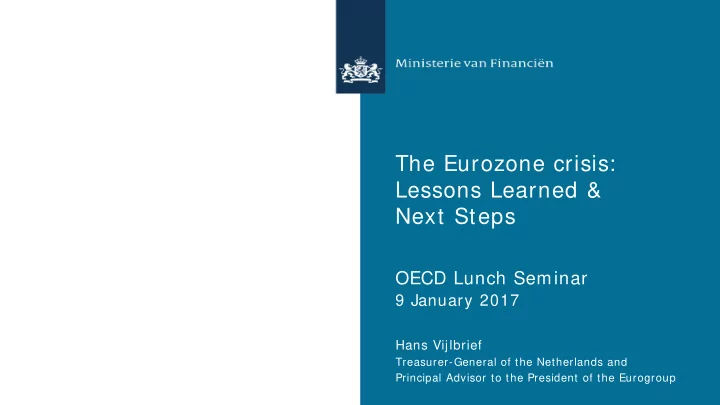

The Eurozone crisis: Lessons Learned & Next Steps OECD Lunch Seminar 9 January 2017 Hans Vijlbrief Treasurer-General of the Netherlands and Principal Advisor to the President of the Eurogroup
Outline I. The Eurozone: where are we now? II. Lessons learned from the crisis III. Undertaken steps since the Euro crisis IV. Next steps for the Eurozone 2
I . THE EUROZONE: W HERE ARE W E NOW ?
Eurozone faced double dip but output gaps are now closing Eurozone experienced double dip Output gap steadily reduced 4 I. The Eurozone: Where are we now?
Domestic demand and labour participation have picked up Dom estic dem and driving EZ grow th Gradual rise of labour participation 5 I. The Eurozone: Where are we now?
Labour market conditions have shown considerable improvement Large reduction of unem ploym ent Em ploym ent grow th rebounds in form er crisis countries since 2 0 1 2 6 I. The Eurozone: Where are we now?
I I . LESSONS LEARNED FROM THE EURO CRI SI S
Start Eurozone coincided with buildup of global financial bubbles 8 II. Lessons learned from the Euro crisis
Lesson 1 Structural impediments can cause misallocation of labour and capital
Allocation of capital, credit and labour to non-tradable sectors contributed to divergence in productivity Large dispersion in labour flow to Contributing to divergence in building and construction sector productivity 10 II. Lessons learned from the Euro crisis
Lesson 2 Adequate buffers are required for anti-cyclical policy during crises
Buildup of buffers was inadequate before crisis Structural deficits not reduced before Buffers eroded rapidly the crisis 12 II. Lessons learned from the Euro crisis
Lesson 3 Insufficient risk perception led to improper financial incentives
After EMU markets no longer differentiated between credit risks I nterest rates converged after introduction Euro until start of financial crisis II. Lessons learned from the Euro crisis 14
Lesson 4 Alternative adjustment mechanisms are essential for a functioning currency union
Capital & credit markets and internal devaluation are important adjustment mechanisms Capital m arkets can play im portant I nternal devaluation accelerates role in sm oothing asym m etric shocks adjustm ent 16 II. Lessons learned from the Euro crisis
I I I . UNDERTAKEN STEPS SI NCE THE EURO CRI SI S
Many undertaken steps within Eurozone after the crisis I ntroduction of rescue funds ( EFSF, ESM) • I m plem entation of structural reform s in country • program m es ( GR, PT, I E) Strengthening of fiscal and econom ic governance • ( tw opack, sixpack) Start of banking union and application of bail-in • 18
Undertaken steps have improved the fiscal position and supply side Deficits and debt in Eurozone have Country program m es have led to declined im plem entation of reform s 19 III. Undertaken steps since the Euro crisis
Banking union has contributed to delinking sovereign and bank risks Spread betw een CDS of banks and sovereigns has increased 20 III. Undertaken steps since the Euro crisis
I V. NEXT STEPS FOR THE EUROZONE
Next Steps Com plete Banking Union and solve debt legacy • Progress on Capital Markets Union • Strengthen fiscal buffers • I ncrease potential output and real convergence through • structural reform s Prom ote inclusive grow th • 22
Completion of banking union and progress on CMU and insolvency frameworks Solving legacy debt: reduce NPLs Level of NPLs differ w ithin eurozone IV. Next steps for the Eurozone 23
Strengthen fiscal buffers and increase potential growth Structural budget deficit above SGP norm Real convergence starts to resum e IV. Next steps for the Eurozone 24
Gains can be made in spreading growth more evenly GI NI coefficient has increased in som e countries IV. Next steps for the Eurozone 25
Summing up The Eurozone econom y has seen solid grow th • The Euro crisis show ed us the consequences of financial • bubbles as w ell as design flaw s The Eurozone has im plem ented effective reform s in a short • tim e Further focus needed on legacy debt, real convergence and • inclusiveness 26
Recommend
More recommend